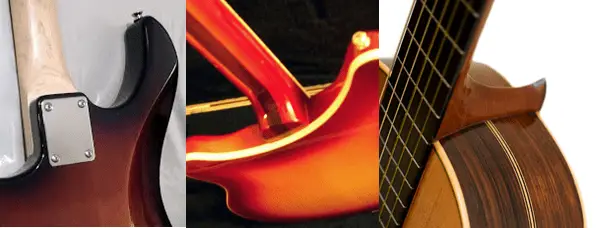Did you know that the Heel can play a rather important role in terms of Tone? There are Two types of Heels each provide a series of pros and cons for your instrument.
What Is A Heel On A Guitar? A Heel (also known as neck joint) is a component on the guitar that gives support to a guitar. It is a ‘joint like’ structure that can take the appearance of a metal plate and screws (if bolted) or a block of wood (if glued).
In this article, I will take you through the Two types of Heels and lay down some important factors that a guitarists must be aware of.
1. What is a Heel / What is Spanish Heel?
The production process to make a guitar is very complex and mostly done by hand. To make this process slightly easier the Neck and Body are produced separately whereby these parts will later be attached together. However, a guitar is constantly under a lot of pressure due to the tension of the strings. There is a real weakness at the point the where the neck and body meet.
The Heel is a component (either a block of wood, metal plate or groove) that adds support and provides stability at the weakest point (where the Body and Neck meet).
2. Where is the Heel Located on a Guitar?
The Heel is always located on the backside of the guitar and the locations can be described in two ways. Either at the top of the guitars body, or at the bottom of the guitar neck at the point where the guitar body and guitar neck meet.
3. Types of Heels on a Guitar
The Heels just refer to how it was manufactured. For example, the bolted Heel means the neck and body of the guitar is attached by a metal plate and four screws. Whilst the Glued Heel means the Neck and Body was attached with glue.
Three types of Heels are:
- Bolted Heel – Also called the Bolted Neck Joint
- Glued Heel – Also called the Sealed Neck Joint
- Spanish Heel – Also a Glued Heel but looks more like a doorway arch

As all guitars are different, you can identify this as being a bolt and screws, a ridge or a block of wood (Spanish heel).
It is also important to note that a very small fraction of guitars do not have Heels. This is because the body and neck was produced as one piece of wood, with the sides stuck on later. This will be referred to as being a through-neck guitar.
4. Why is a Heel Important?
A Heel has an essential role of adding tuning stability between the Neck and the Body. But, the type of Heel you use also provides an important role. The two types of Heels provide an important role in a guitarist’s collateral which is usually down to the price, tone, environment and general taste.
For example, Bolted Heels are required as the neck can be easily replaced whenever damaged or broken. This makes them the perfect guitar for gigging and just throwing about. Fenders make all their guitars this way for this reason.
Furthermore, Glued Heels cannot be replaced as easily. However, they do provide a richer tone making them perfect for the studio. You will find Gipson Les Pauls are always made this way as people say this directly influences better tone.
Conclusion
In this article we looked at all the different types of heels to provide you with a good understanding of what look out for when searching in the market.
